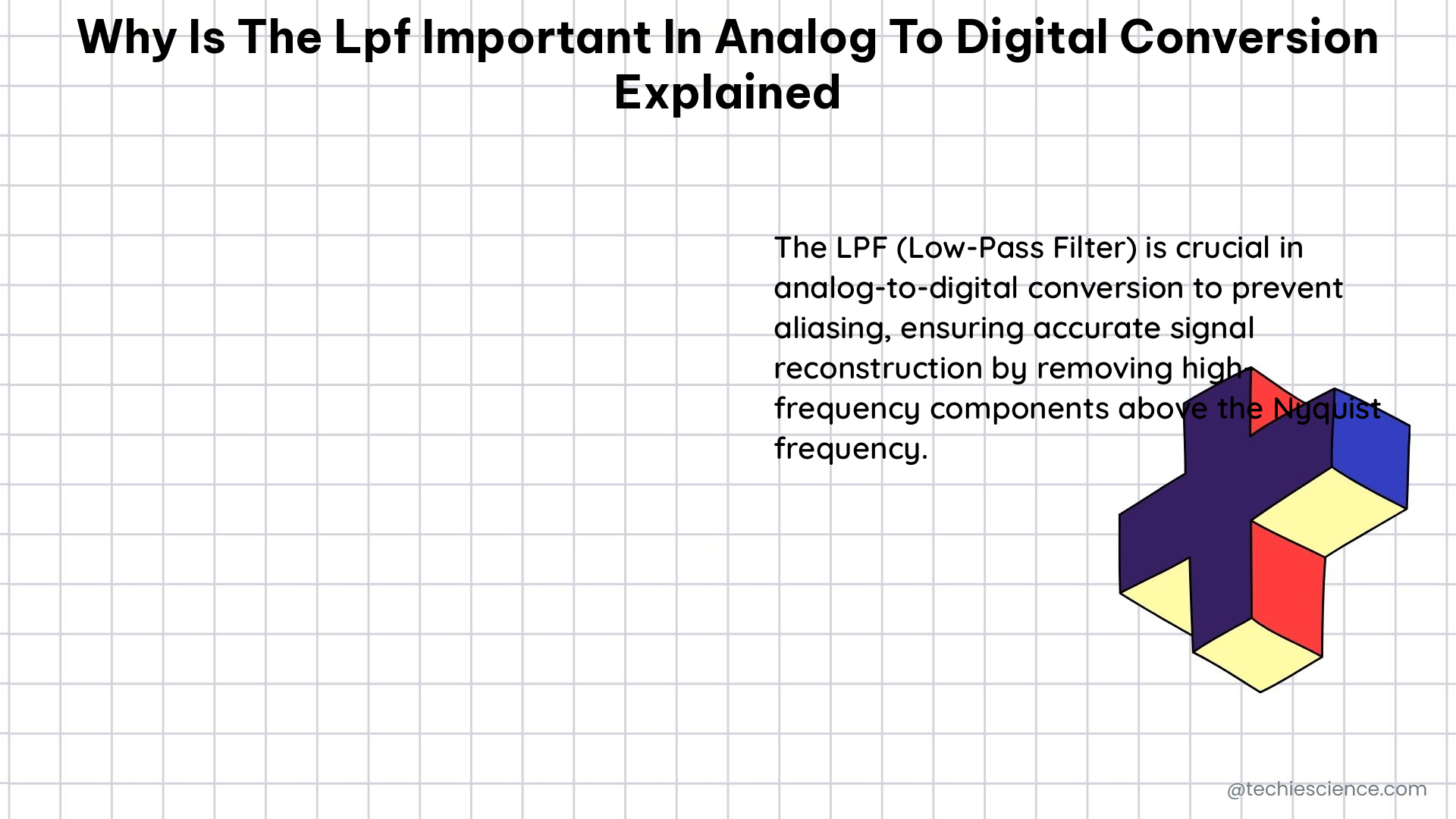The low-pass filter (LPF) is a crucial component in analog-to-digital conversion (ADC) as it eliminates high-frequency components from the input analog signal, preventing the phenomenon of aliasing. Aliasing occurs when higher frequencies in the input signal are incorrectly interpreted as lower frequencies in the digital representation, leading to distorted data. By using an LPF before the ADC, the input signal is limited to a range of frequencies that can be accurately represented in the digital domain.
Understanding the Nyquist-Shannon Sampling Theorem
The Nyquist-Shannon Sampling Theorem is a fundamental principle that governs the relationship between the sampling frequency and the highest frequency present in the input signal. The theorem states that a continuous-time signal can be perfectly reconstructed from its samples if the sampling frequency is at least twice the highest frequency of the signal. This is known as the Nyquist frequency.
If the input signal contains frequencies higher than half the sampling frequency (the Nyquist frequency), these higher frequencies will be incorrectly interpreted as lower frequencies in the digital representation, leading to aliasing. The LPF ensures that the input signal meets the Nyquist criterion, preventing aliasing and ensuring accurate digital representation.
For example, consider an analog signal with a maximum frequency of 20 kHz. To satisfy the Nyquist criterion, the sampling frequency must be at least 40 kHz (2 × 20 kHz). If the sampling frequency is lower, such as 30 kHz, the higher frequencies above 15 kHz (half the sampling frequency) will be aliased, resulting in distortion in the digital signal.
Quantifying Aliasing Error

Aliasing error can be quantified as the difference between the original signal and the aliased signal. The LPF reduces this error by limiting the input signal’s frequency content, making the digital representation more accurate.
The aliasing error can be calculated using the following formula:
Aliasing Error = ∑ |X(f) - X(f - nfs)|
Where:
– X(f) is the original signal spectrum
– X(f - nfs) is the aliased signal spectrum
– fs is the sampling frequency
– n is an integer representing the harmonic index
By reducing the high-frequency components in the input signal, the LPF effectively minimizes the aliasing error, resulting in a more accurate digital representation.
Improving Signal-to-Noise Ratio (SNR)
The LPF can also improve the SNR of the digital signal by reducing the noise present in the input signal. High-frequency noise components are often of lower amplitude than the signal of interest, and the LPF can effectively filter out these components, improving the overall SNR.
The SNR of the digital signal can be calculated as:
SNR = 10 log10(Signal Power / Noise Power)
Where the signal power and noise power are measured within the passband of the LPF. By reducing the noise power, the LPF can significantly improve the SNR, leading to a cleaner and more accurate digital representation of the analog signal.
Characterizing LPF Performance
The performance of the LPF can be characterized by several key parameters:
- Passband Ripple: The maximum deviation from the ideal response in the passband. Lower passband ripple indicates a better-performing LPF.
- Stopband Attenuation: The minimum attenuation in the stopband. Higher stopband attenuation indicates a better-performing LPF.
- Transition Width: The frequency range over which the filter transitions from the passband to the stopband. A narrower transition width indicates a sharper cutoff, which reduces aliasing and improves the overall performance of the ADC.
These parameters can be used to design and select appropriate LPFs for specific ADC applications. For example, an LPF with a narrow transition width and high stopband attenuation would be more effective in preventing aliasing and improving the accuracy of the digital signal.
Practical Considerations in LPF Design
In real-world ADC systems, the design of the LPF must consider several practical factors:
- Cutoff Frequency: The cutoff frequency of the LPF should be chosen carefully to balance the trade-off between aliasing prevention and signal bandwidth. A lower cutoff frequency may reduce aliasing but also limit the usable bandwidth of the digital signal.
- Filter Order: The order of the LPF filter determines its steepness and the sharpness of the transition between the passband and stopband. Higher-order filters generally provide better anti-aliasing performance but may introduce more complexity and group delay.
- Filter Type: Different filter types, such as Butterworth, Chebyshev, or Elliptic, have their own characteristics in terms of passband ripple, stopband attenuation, and transition width. The choice of filter type depends on the specific requirements of the ADC application.
- Implementation: The LPF can be implemented using analog circuitry (e.g., active or passive filters) or digital signal processing (e.g., finite impulse response or infinite impulse response filters). The implementation choice depends on factors such as cost, power consumption, and the desired level of integration with the ADC.
Conclusion
The low-pass filter (LPF) is a critical component in analog-to-digital conversion (ADC) systems, as it plays a crucial role in preventing aliasing and improving the overall accuracy and quality of the digital signal. By understanding the principles of the Nyquist-Shannon Sampling Theorem, quantifying aliasing error, and characterizing the performance of the LPF, designers can optimize the ADC system to meet the specific requirements of their applications.
References:
1. https://electronics.stackexchange.com/questions/616896/digital-signal-processing-vs-analog-signal-processing-for-a-100khz-daq-project
2. https://www.dspguide.com/ch21/1.htm
3. https://www.analog.com/media/en/technical-documentation/dsp-book/dsp_book_Ch14.pdf
4. https://www.geeksforgeeks.org/analog-to-digital-conversion/

The lambdageeks.com Core SME Team is a group of experienced subject matter experts from diverse scientific and technical fields including Physics, Chemistry, Technology,Electronics & Electrical Engineering, Automotive, Mechanical Engineering. Our team collaborates to create high-quality, well-researched articles on a wide range of science and technology topics for the lambdageeks.com website.
All Our Senior SME are having more than 7 Years of experience in the respective fields . They are either Working Industry Professionals or assocaited With different Universities. Refer Our Authors Page to get to know About our Core SMEs.